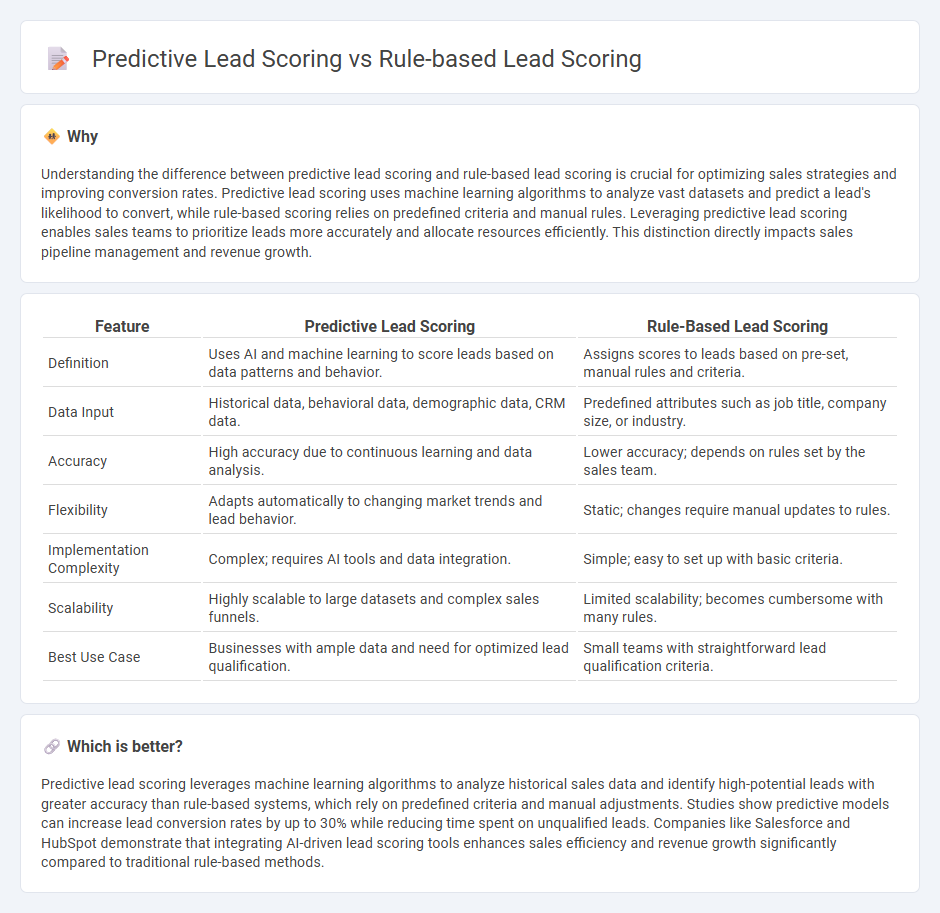
Predictive lead scoring leverages machine learning algorithms and historical data to identify high-potential prospects, offering dynamic and data-driven insights that adapt over time. Rule-based lead scoring relies on predefined criteria and manual rules to assign scores, often lacking flexibility and the ability to uncover hidden patterns. Explore the advantages of each method to enhance your sales strategy and boost conversion rates.
Why it is important
Understanding the difference between predictive lead scoring and rule-based lead scoring is crucial for optimizing sales strategies and improving conversion rates. Predictive lead scoring uses machine learning algorithms to analyze vast datasets and predict a lead's likelihood to convert, while rule-based scoring relies on predefined criteria and manual rules. Leveraging predictive lead scoring enables sales teams to prioritize leads more accurately and allocate resources efficiently. This distinction directly impacts sales pipeline management and revenue growth.
Comparison Table
| Feature | Predictive Lead Scoring | Rule-Based Lead Scoring |
|---|---|---|
| Definition | Uses AI and machine learning to score leads based on data patterns and behavior. | Assigns scores to leads based on pre-set, manual rules and criteria. |
| Data Input | Historical data, behavioral data, demographic data, CRM data. | Predefined attributes such as job title, company size, or industry. |
| Accuracy | High accuracy due to continuous learning and data analysis. | Lower accuracy; depends on rules set by the sales team. |
| Flexibility | Adapts automatically to changing market trends and lead behavior. | Static; changes require manual updates to rules. |
| Implementation Complexity | Complex; requires AI tools and data integration. | Simple; easy to set up with basic criteria. |
| Scalability | Highly scalable to large datasets and complex sales funnels. | Limited scalability; becomes cumbersome with many rules. |
| Best Use Case | Businesses with ample data and need for optimized lead qualification. | Small teams with straightforward lead qualification criteria. |
Which is better?
Predictive lead scoring leverages machine learning algorithms to analyze historical sales data and identify high-potential leads with greater accuracy than rule-based systems, which rely on predefined criteria and manual adjustments. Studies show predictive models can increase lead conversion rates by up to 30% while reducing time spent on unqualified leads. Companies like Salesforce and HubSpot demonstrate that integrating AI-driven lead scoring tools enhances sales efficiency and revenue growth significantly compared to traditional rule-based methods.
Connection
Predictive lead scoring leverages machine learning algorithms to analyze historical sales data and identify patterns indicating high-quality leads, while rule-based lead scoring assigns scores based on predefined criteria set by sales teams. Both methods aim to prioritize leads by assessing their likelihood to convert, improving sales efficiency and targeting. Integrating rule-based frameworks with predictive analytics creates a hybrid scoring model that enhances accuracy in lead qualification and drives higher sales conversions.
Key Terms
Criteria weighting
Rule-based lead scoring relies on predefined criteria weighted according to business rules, often assigning fixed point values based on demographic and behavioral factors. Predictive lead scoring uses machine learning algorithms to analyze historical data and dynamically adjust criteria weighting, improving accuracy by identifying patterns that correlate with conversion likelihood. Explore how these approaches impact lead qualification effectiveness and optimize your sales strategy.
Machine learning
Rule-based lead scoring relies on predefined criteria set by sales or marketing teams, using explicit rules to assign scores to leads based on demographic or behavioral attributes. Predictive lead scoring leverages machine learning algorithms to analyze historical data and identify patterns that predict lead conversion likelihood with greater accuracy and adaptability. Explore the advantages of machine learning in optimizing lead scoring models and transforming sales strategies.
Behavioral data
Rule-based lead scoring utilizes predefined criteria such as website visits and email opens to assign scores, relying heavily on explicit behavioral signals. Predictive lead scoring leverages machine learning algorithms to analyze complex behavioral patterns and historical data, enhancing accuracy in identifying high-potential leads. Explore the advantages of integrating behavioral data in lead scoring models for more efficient sales strategies.
Source and External Links
Rule-Based Lead Scoring: Overview - Rule-based lead scoring involves setting up predefined rules based on desired or undesired characteristics to assign points to leads, dynamically adjusting their score as they exhibit relevant behaviors or attributes, and qualifying them once they meet a minimum score threshold.
The Ultimate Guide to Lead Scoring - Rule-based lead scoring balances points assigned for characteristics and behaviors, giving leads scores based on their fit and engagement to prioritize those with the highest likelihood to convert.
Scoring rules: How to win more sales by rating your leads - Rule-based lead scoring is a manual approach that assigns scores based on lead demographics and behaviors, contrasting with predictive lead scoring which uses AI to assess likelihood to convert.
 dowidth.com
dowidth.com